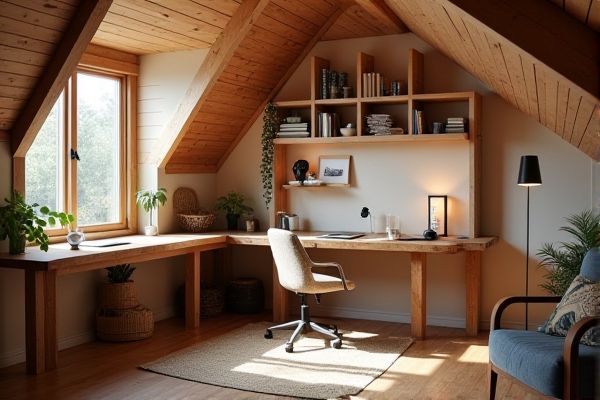
An attic desk is designed for organized office tasks, offering ample surface area and storage for paperwork and computer equipment, while an attic workbench is built to withstand heavy-duty projects with a durable top and tool storage. Discover which option suits Your attic workspace best by exploring the differences in functionality and design detailed below.
Table of Comparison
| Feature | Attic Desk | Attic Workbench |
|---|---|---|
| Primary Use | Office work, writing, laptop use | Tool use, repairs, crafting |
| Design | Compact, ergonomic, often foldable | Sturdy, heavy-duty, large surface |
| Material | Wood, MDF, sometimes metal | Solid wood, metal frame |
| Storage | Drawers, shelves for office supplies | Tool racks, pegboards, heavy storage |
| Weight Capacity | Light to moderate load | High load capacity for tools and equipment |
| Height | Standard desk height (~29-30 inches) | Varies, often taller for standing work |
| Space Efficiency | Optimized for small attic spaces | Requires more space due to size |
| Cost | Moderate | Higher due to durability |
Introduction to Attic Workspaces
Attic desks optimize compact spaces with sleek, vertical designs perfect for focused tasks and light storage, making them ideal for small attic work areas. Attic workbenches provide robust surfaces with integrated tool storage, designed to support heavier projects and crafts. Choosing the right attic workspace depends on your specific needs, balancing functionality with available attic dimensions.
Key Differences: Attic Desk vs Attic Workbench
An attic desk is designed primarily for tasks requiring a flat, ergonomic surface such as writing, reading, or using a laptop, often featuring storage for office supplies and compact design to fit limited attic space. An attic workbench prioritizes heavy-duty functionality with a sturdy, durable surface suitable for woodworking, crafts, or mechanical projects, typically including tool organizers and reinforced construction. While both optimize space in attics, the desk focuses on lightweight productivity, whereas the workbench emphasizes robustness and utility for hands-on activities.
Space Utilization in Attic Conversions
Attic desks maximize workspace in tight attic conversions by offering compact, vertical storage solutions that fit under eaves and sloped ceilings. In contrast, attic workbenches provide a sturdier surface ideal for crafts or repairs, often requiring more floor area but enabling better organization of tools and materials. Optimizing space utilization depends on the intended use, with desks favoring efficiency and workbenches supporting functionality in attic settings.
Workstation Design and Ergonomics
An attic desk offers a compact, height-adjustable workstation designed to maximize ergonomic comfort for tasks requiring seating, while an attic workbench provides a sturdy, fixed-height surface ideal for standing projects and heavy-duty use. The desk often includes features like cable management and drawers to enhance organization and reduce strain during prolonged work, whereas the workbench emphasizes durability and ample space for tools and materials. Choosing the right option depends on your specific needs for posture support, workspace layout, and the nature of your attic activities.
Storage Solutions: Desk vs Workbench
An attic desk offers integrated storage options like drawers and shelves designed for organizing office supplies and paperwork, maximizing small spaces efficiently. In contrast, an attic workbench provides robust storage with tool racks, pegboards, and heavy-duty bins better suited for bulky tools and materials. Your choice depends on whether you need streamlined storage for work or versatile, durable organization for DIY projects.
Functional Uses: Productivity and Hobbies
An attic desk offers a compact, ergonomic space designed primarily for focused productivity tasks such as writing, computer work, and organizing paperwork. In contrast, an attic workbench provides a durable, open surface ideal for hands-on hobbies like woodworking, crafting, and DIY repairs that require tool storage and versatility. Your choice depends on whether your attic is dedicated to intellectual work or practical, creative projects.
Material and Construction Considerations
Attic desks are often made from lighter materials such as MDF or plywood to reduce weight and ensure easy installation in confined attic spaces, while attic workbenches prioritize sturdier construction using solid wood or metal to withstand heavy-duty tasks and support more weight. The choice of material directly impacts durability and stability, with workbenches typically featuring reinforced frames and thicker surfaces tailored for tools and equipment. Your decision should consider the balance between portability and robustness depending on the type of activities planned in the attic.
Noise and Distraction Management
An attic desk offers a quieter workspace by minimizing noise and distractions, as it is typically enclosed and smaller, isolating users from ambient sounds. In contrast, an attic workbench may generate more noise due to its open design and the nature of physical tasks like hammering or sanding, which can cause vibrations and sound disturbances. Effective noise and distraction management in attics depends on insulation, layout, and material choices to maintain productivity and focus.
Cost Comparison and Budget Planning
An attic desk generally costs less than an attic workbench due to its simpler design and lighter materials, making it a budget-friendly option for light tasks. Attic workbenches often involve sturdier construction and durable surfaces, increasing initial investment but offering long-term value for heavy-duty projects. Careful budget planning should consider both upfront costs and intended use to balance affordability with functionality in attic workspace solutions.
Choosing the Best Option for Your Needs
An attic desk offers a compact, organized workspace ideal for tasks requiring minimal tools and paperwork, making it perfect for focused activities like writing or laptop use. An attic workbench provides a sturdier, larger surface designed to accommodate heavy-duty projects and tools, suited for woodworking or crafts that demand durability and space. Assess your primary activities and storage needs to select the option that best supports your productivity and comfort in the attic environment.
 homyna.com
homyna.com